After a tremendous start to the Challenger Pro League campaign for Beerschot, in which they were top of the league for an extended period, manager Andreas Wieland informed the club just before Christmas that he wished to leave the club to take up the technical director role at his previous club, Austrian Bundesliga side LASK.
After his departure, Beerschot turned to what many thought was a rather surprising name, appointing former Liverpool striker Dirk Kuyt. The 43-year-old Dutchman had previously managed ADO Den Hag in the Netherlands but was sacked after a poor run of form and less than a year in charge.
However, since his appointment at Beerschot, the Belgian side have only lost two times in 12 league matches under Kuyt, confirming automatic promotion back to the Belgian Pro League last weekend after beating Oostende. This tactical analysis will take a detailed look at Beerschot’s tactics under Kuyt and what to expect from them back in the Pro League next season.
Build-up & attacking tactics
This first section will examine Beerschot’s in-possession tactics under Dirk Kuyt and how they have been impactful in the club’s eventual promotion back to the Belgian Pro League. Since Kuyt was appointed, he has tended to set his side up in a 3-4-3 starting formation, which usually shifts to some variation of a back five when they are forced to drop back and defend against opposition attacks.
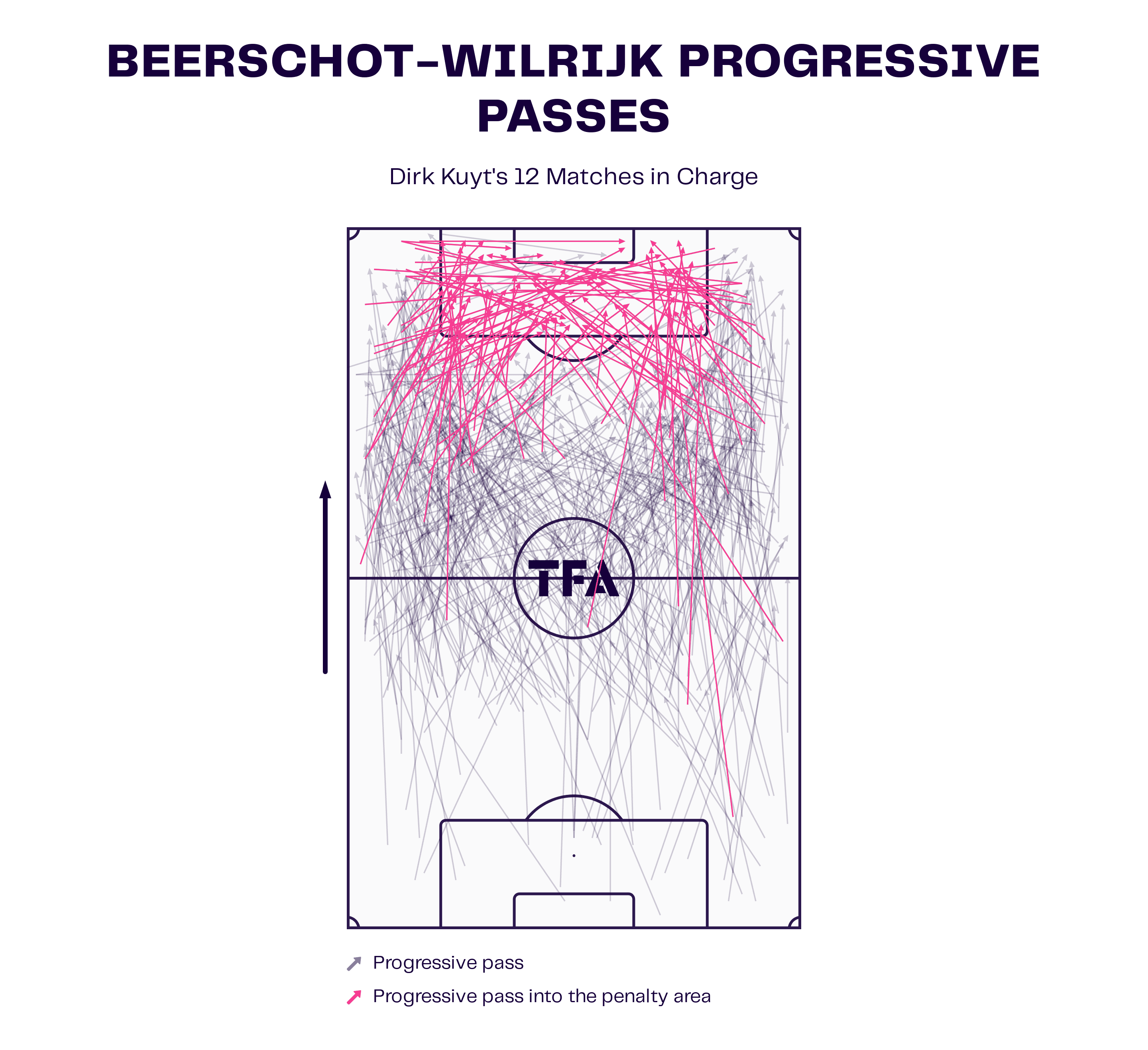
The data viz graphic above shows Beerschot’s progressive passes since Kuyt’s appointment at the end of December. As we can see, most of the passes into the penalty area have occurred from either the wide areas or the half spaces, with off-the-ball movement and verticality in the attack two key factors in how Kuyt wants his side to attack with the ball.
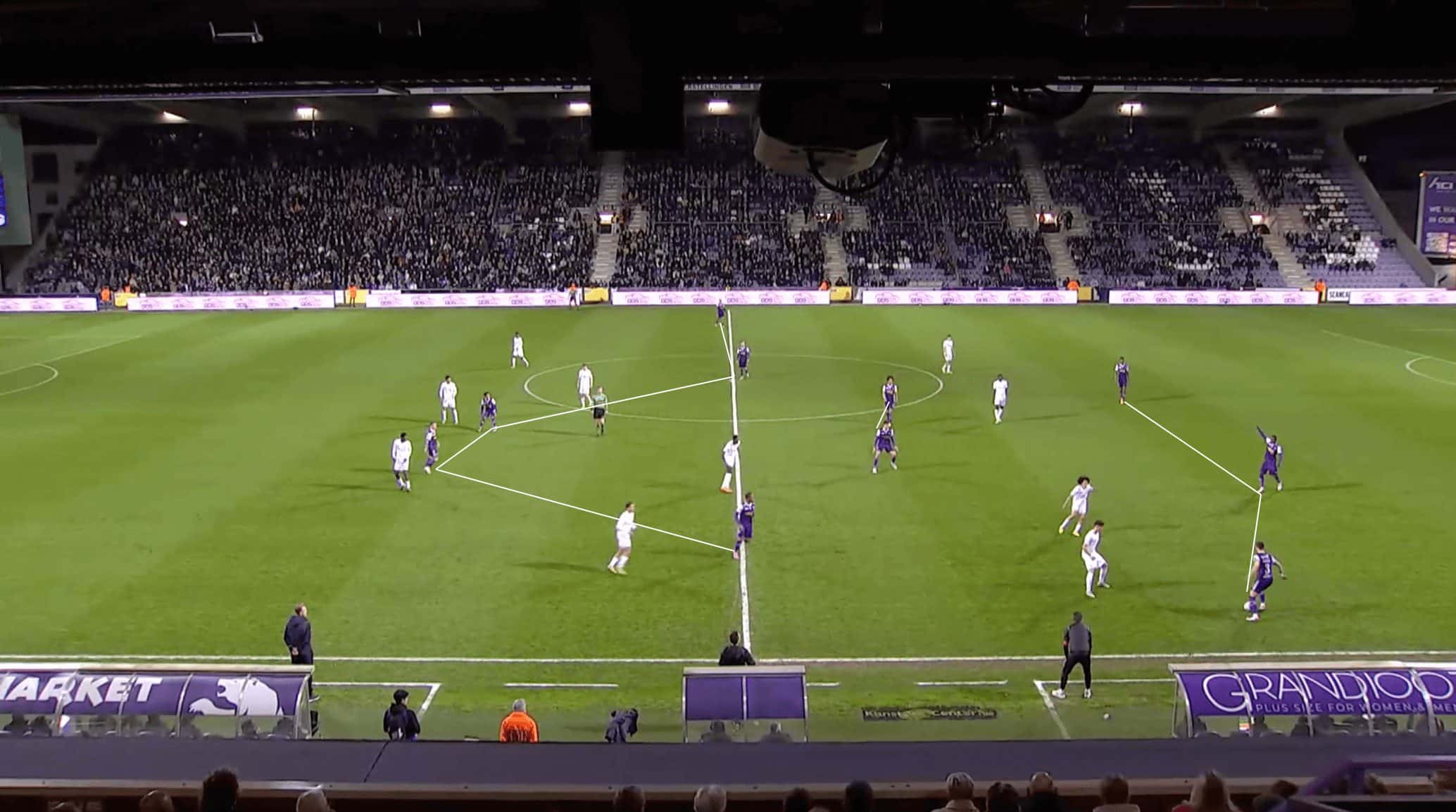
The image above shows the typical shape that Beerschot looks to implement during the attacking phases of play. While Kuyt’s side does look to play long initially from goal kicks at times, their most common route of ball progression is building from the back, emphasising verticality and forward movement off the ball to open gaps in advanced areas. As we can see from the figure, the shape tends to turn into a 3-2-5, with the five furthest forward-looking to roam and find pockets of space in the midfield.
As we can see from this example, the shape looks more like a 3-2-3-2, but this has come as a result of interchanging movements off the ball from Kuyt’s side, looking to pull the opposition shape apart and create gaps in central areas for the ball to be progressed vertically. The double-pivot staying deep allows the Beerschot centre-backs to build between them and switch the play from side to side without much pressure, as these two are able to keep the opposition forwards more passive in their pressing shape.
The deeper lying midfield pairing also allows the centre-backs to play them as options, with this normally resulting in bounce passes that open up the spaces needed to progress the ball vertically. This attacking shape normally allows the Belgian side to have a numerical advantage against their opposition in the midfield while also allowing the wingbacks on the touchlines to be isolated 1v1 against the opposition’s full-backs.
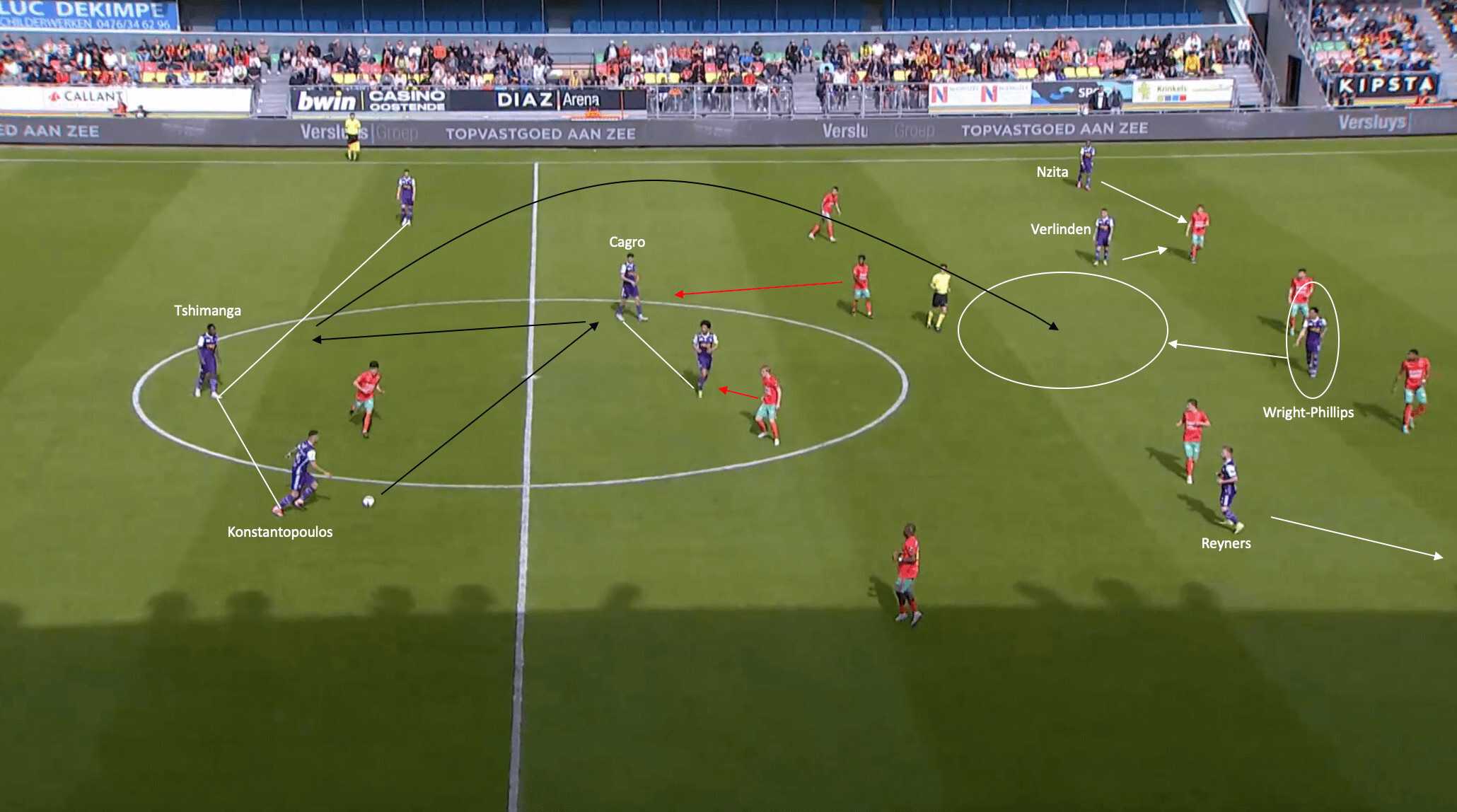
The image above shows another attacking phase for Beerschot, and highlights in more detail what the Belgian side have looked to do in possession. As we can gather from the figure, Kuyt’s side are in possession and looking to build from the back. The shape is a clearly defined 3-2-5, with the wing-backs and wide midfielders on both touchlines creating overloads against the opposition full-backs in Oostende’s 4-1-4-1 formation.
Striker D’Margio Wright-Phillips is occupying both opposition centre-backs, with Oostende’s single pivot looking to man-mark Beerschot danger man Tom Reyners, being dragged out of the midfield as a result of Reyner’s movement. After being rotated around the backline, the ball eventually comes to the feet of Greek centre-back Apostolos Konstantopoulos, with the defender playing a two-touch pass vertically to the feet of midfielder Welat Cagro.
The Belgian midfielder proceeds to play a bounce pass back to Derrick Tshimanga, with this initial pass to Cagro dragging the two Oostende central midfielders deeper to look to put pressure on the ball. This opens up the space centrally, with Wright-Phillips dropping into this space and Tshimanga playing a lofted ball over the top for the English striker to control, with the centre-backs not looking to mark and follow him into the space. This movement and quick ball progression allows Beerschot to continue to build, opening up more gaps as a result of pulling the Oostende defence around.
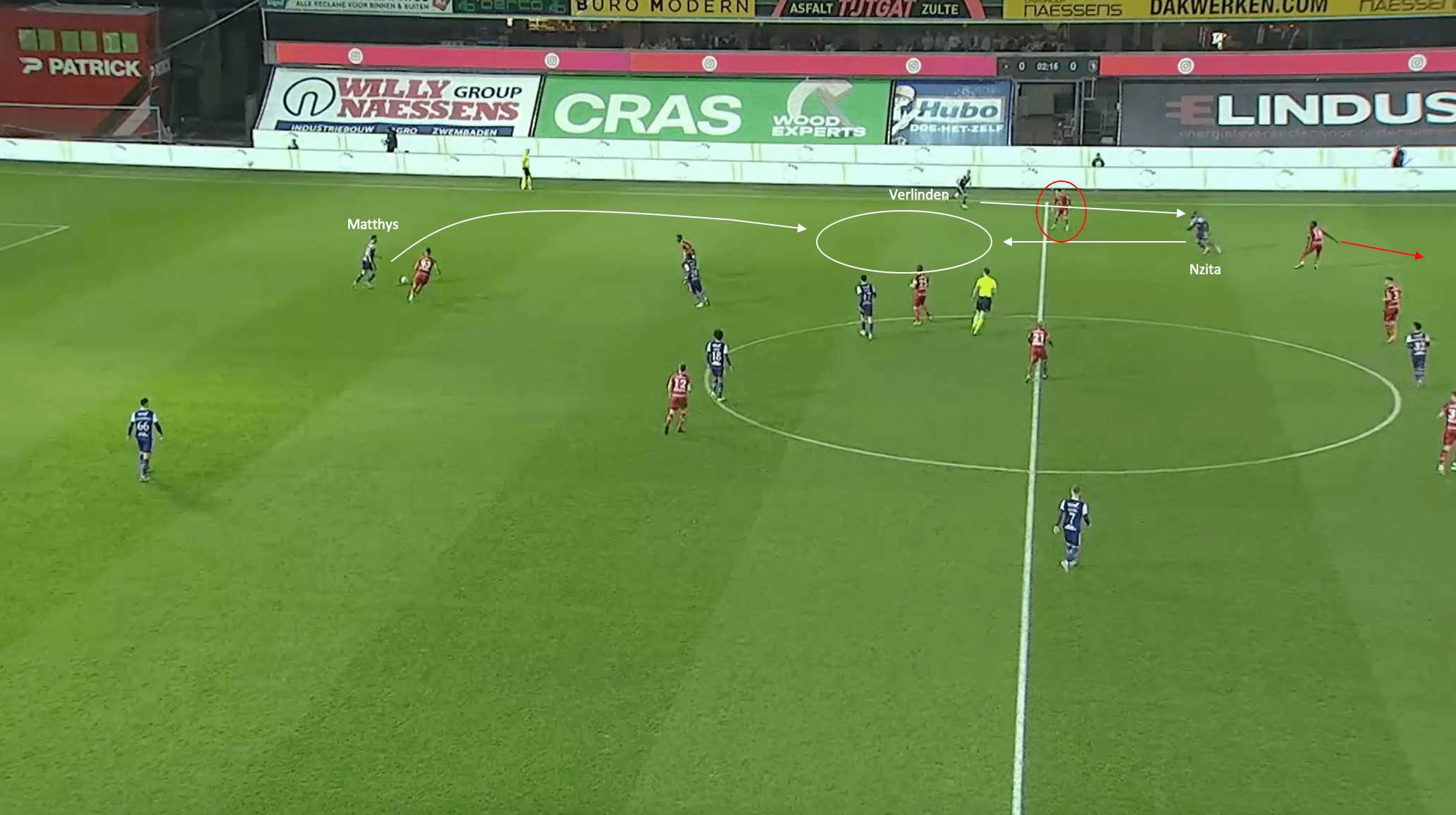
The image above shows another attacking phase of play from Beerschot, with the Belgian side again looking to build out from the back, utilising the same 3-2-5 shape. Against Zulte-Waregem, Vincent Euvrard matched up with Beerschot formationally, with the Belgian coach also setting his side up in a 3-4-3 starting formation. Euvrard’s side looked to go man-to-man with Beerschot, making off-the-ball movements in advanced positions crucial for Kuyt’s side to progress the ball vertically.
In this specific phase of play, the ball is in possession of Hervé Matthys, with the Belgian centre-back looking to play forward. Tshimanga moves forward into midfield, with the opposition attacker looking to mark the defender, allowing Matthys the space to move into to find a clear passing lane. Further forward in the ball-side wide channel, Beerschot has managed to create an overload, isolating the Zulte-Waregem wing-back in a 2v1, with Thibaud Verlinden and Mardochée Nzita operating in this wide channel.
Nzita inverts, with Verlinden moving outside to hold the width, with the two players making opposite movements at the same time. Nzita looks to drop into the pocket in the halfspace, with Verlinden looking to make a run beyond the isolated defender on the outside. These movements freeze the defender, with him instead looking to hold the space to try and split the two. Matthys proceeds to play the ball to Nzita’s feet, with the 24-year-old afforded the space to turn and drive into the space before attempting to find Verlinden out wide.
As this section has been able to illustrate, Dirk Kuyt has looked to install positional superiority to how Beerschot have looked to progress play and attack. The 3-2-5 shape Kuyt implemented has allowed the Belgian side to create numerical advantages in the attacking third, as well as causing trouble for opposition defences since his appointment.
Defensive principles beginning to take shape
This next section will take a look at some of the defensive principles that have been prevalent in how Dirk Kuyt’s Beerschot side have looked to defend. Naturally, as the Belgian side typically start in a 3-4-3 formation, this shape tends to shift into a back five when Beerschot are forced to drop into a more defensive shape.
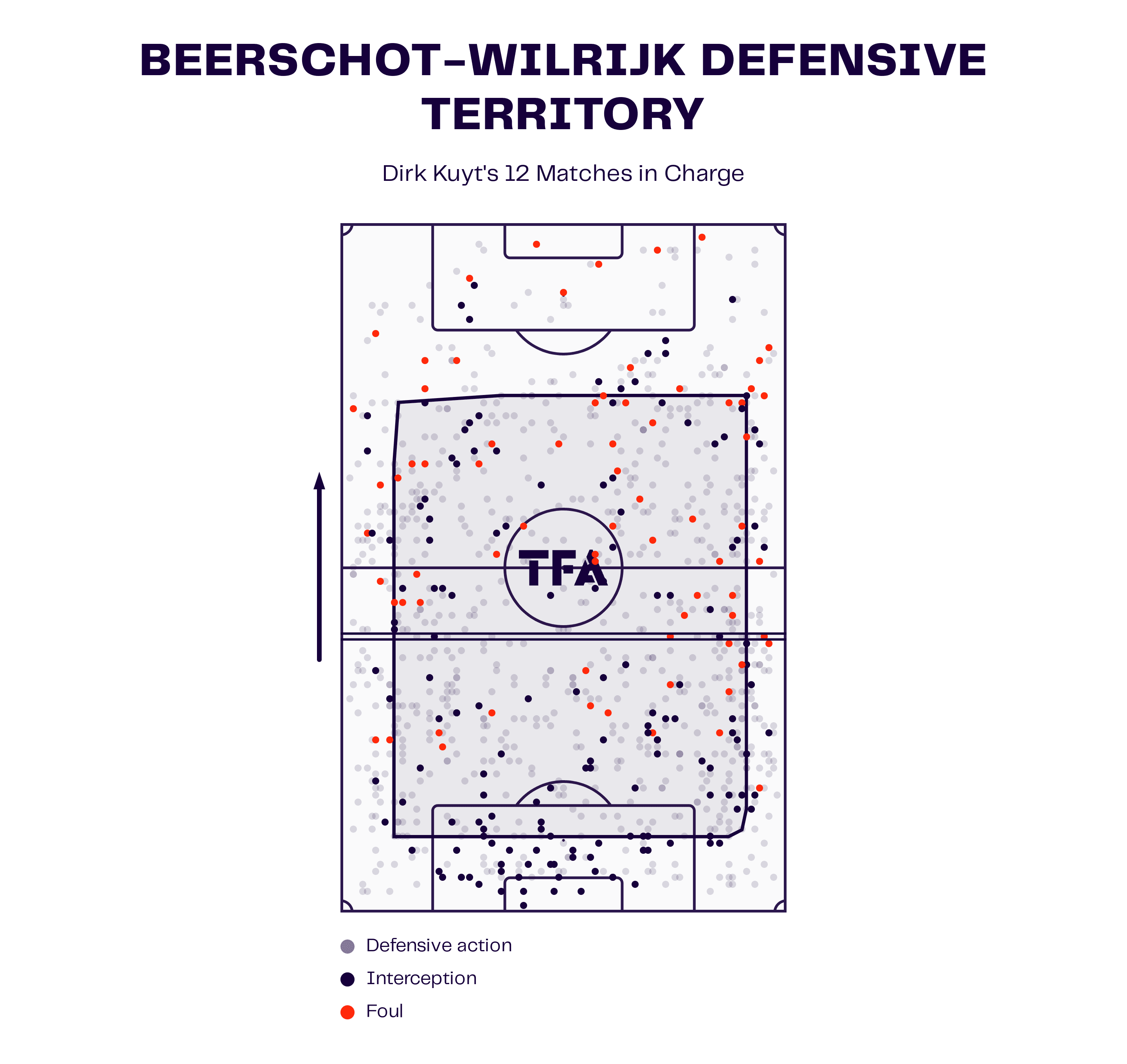
The data viz graphic above shows the defensive territory of Beerschot during Dirk Kuyt’s 12 matches in charge of the Belgian side, with a high defensive line one of the main things to stand out. As we can see, the average height of Beerschot’s defensive line is high, with Kuyt looking for his side to defend from the front and put the opposition under pressure with their pressing, as the next section will talk about in more detail. Focusing back on this graphic, Beerschot also do not look to defend deep inside their own penalty box, with the deepest their defensive line will look to go is just inside the 18-yard box, with the Beerschot defence looking to hold their line and play offside traps.
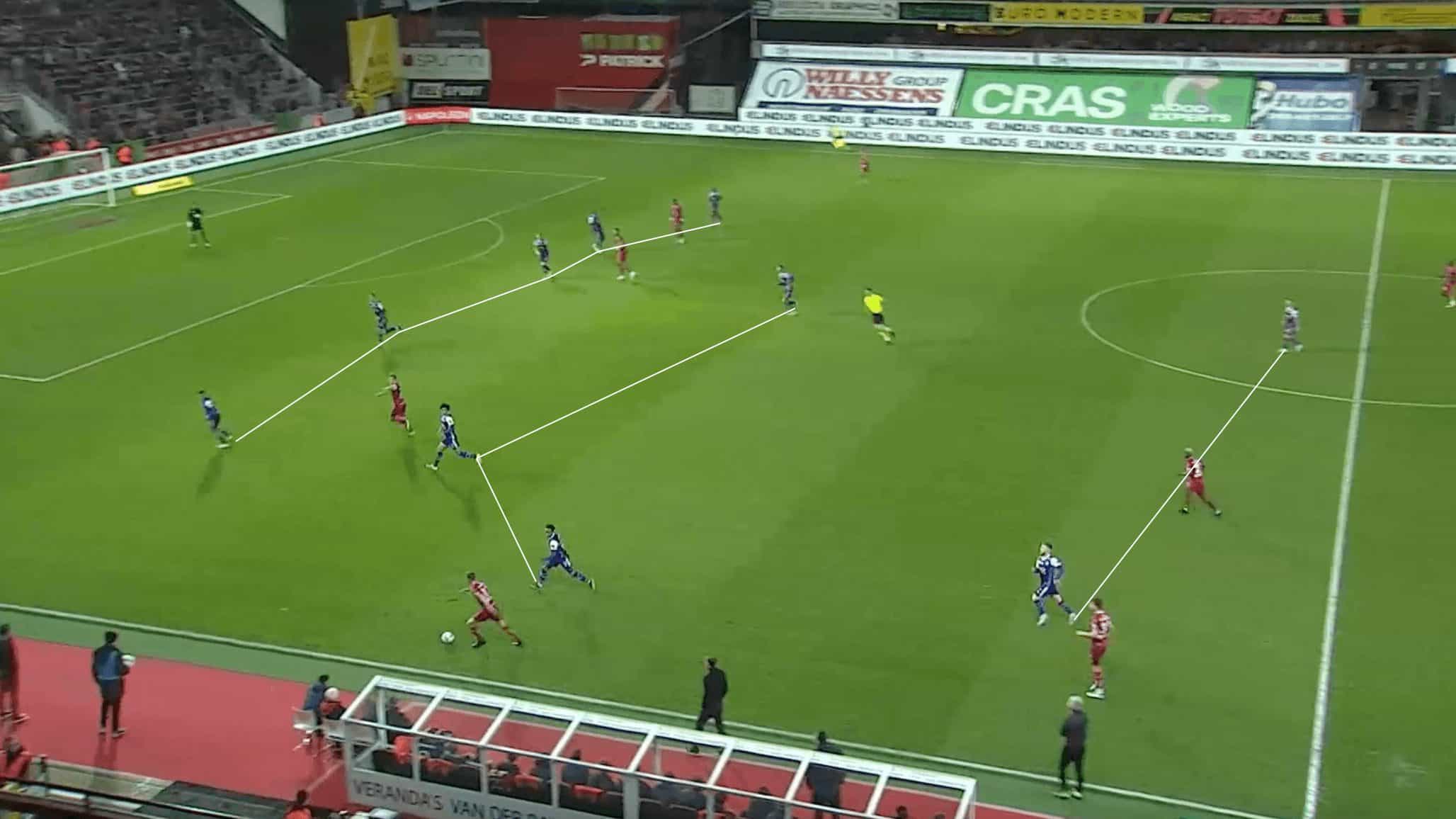
The image above shows an example of their typical defensive shape from their recent Challenger Pro League match against Zulte-Waregem. As we can see, Kuyt’s side are in a 5-3-2 formation, with the defensive line staying tight and compact, looking to prevent any potential central progression from the opposition. The midfield three look to stay close to the defensive line, preventing any potential space from forming between the lines. In more advanced positions, the front two of Beerschot look to stay more disconnected from the rest of the defensive shape, with them staying forward to be outlets if the defence is able to win the ball and play it forward.
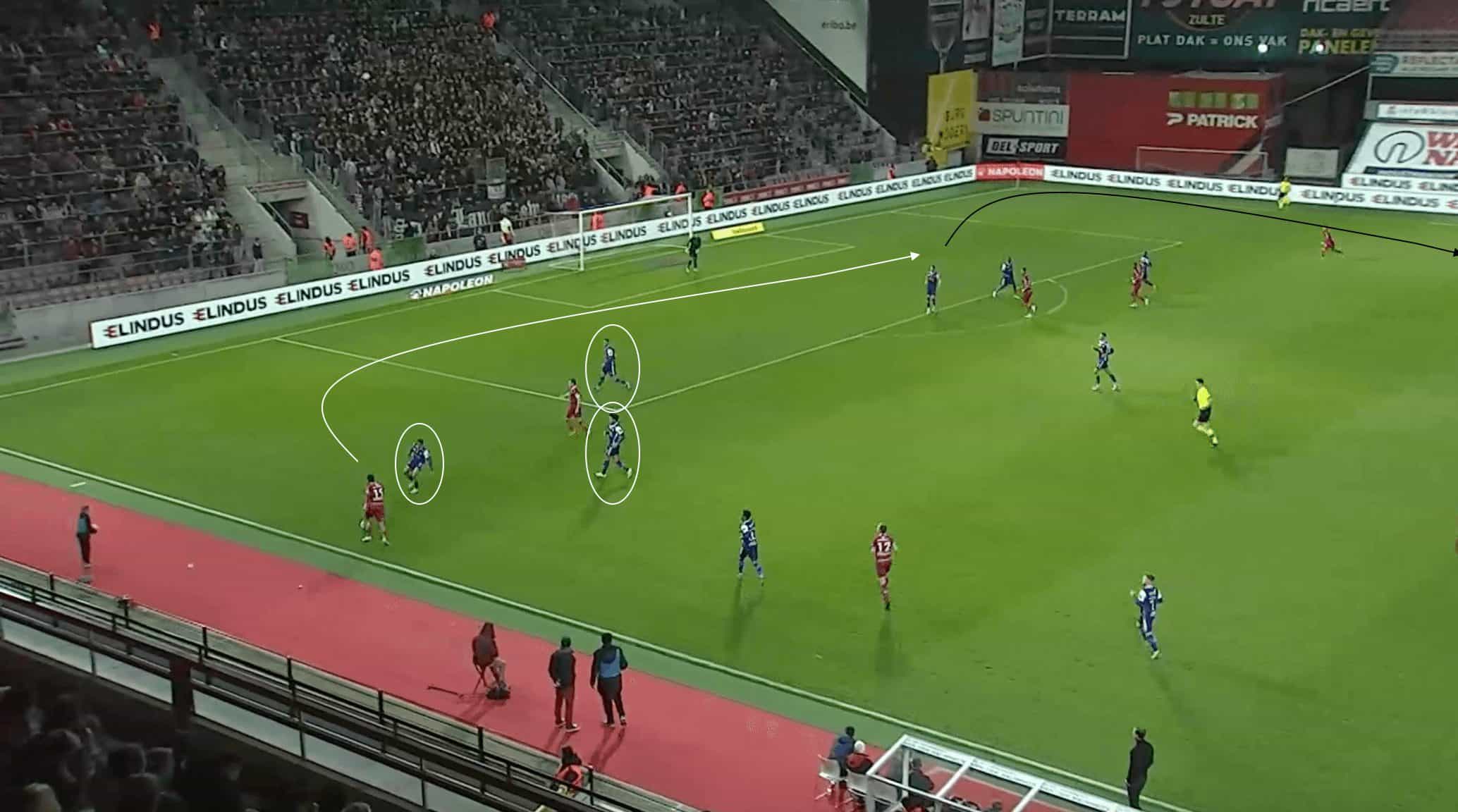
The image above shows what Beerschot have looked to do defensively this season as the ball is progressed into their final third. This figure above follows the previous example, with Zulte-Waregem having to play the ball wide as a result of Beerschot clogging the central areas. As the ball is circulated out wide, Beerschot are able to create a defensive overload against the opposition attackers, with the only option for the wide midfielder to play a cross from a deep area into the penalty area.
However, Beerschot also had an overload in this area centrally, with it again 3v2 inside the penalty box. As a result, the ensuing cross can be cleared away from danger by a Beerschot defender and out of play, allowing the Belgian side to regroup defensively and set up in their defensive shape once again.
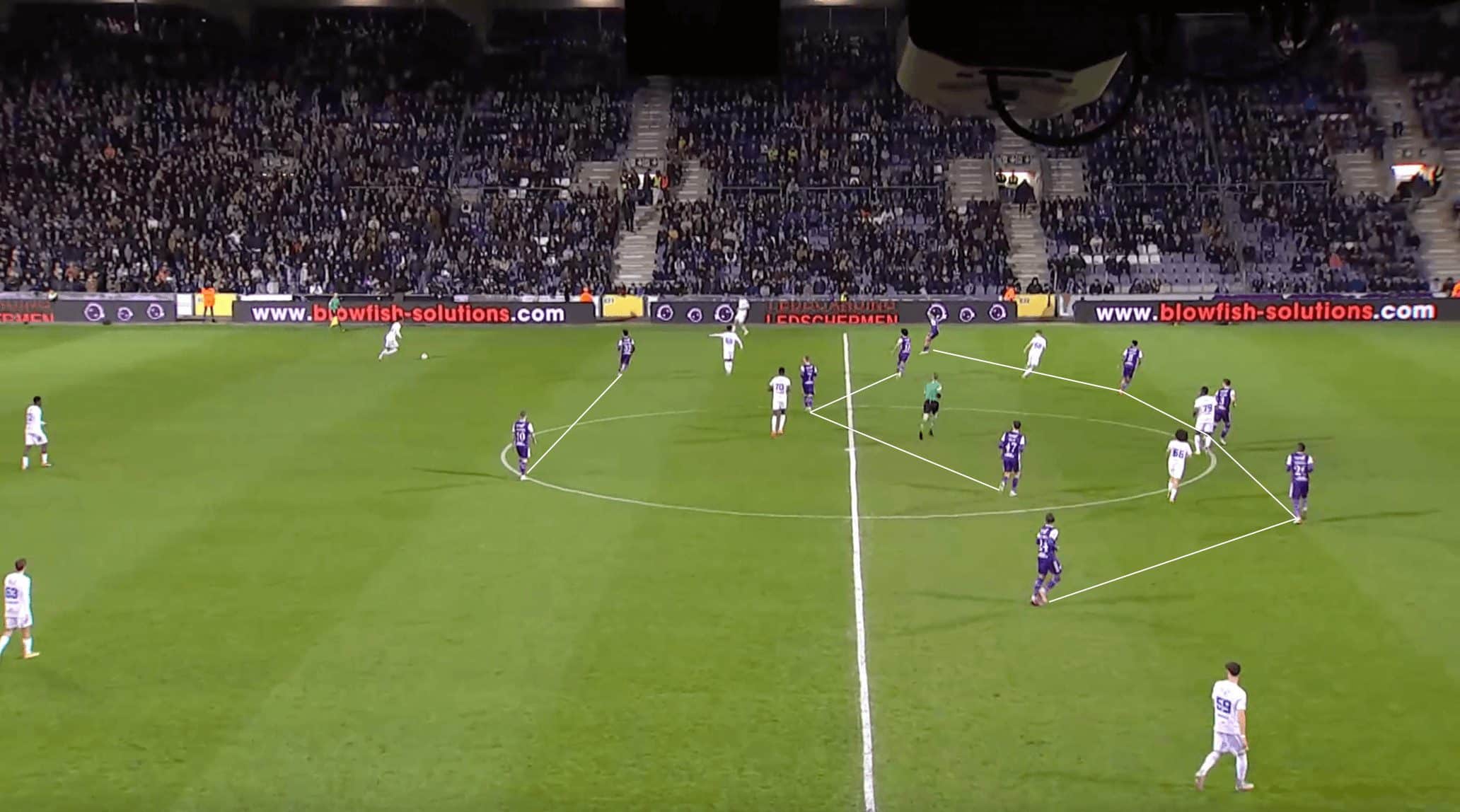
The image above gives a better look at Beerschot’s mid-block defending, with their deep-block defending already covered in the previous examples. As we can see from their mid-block shape, it is again a 5-3-2, with the shape being tightly compact and narrow to prevent forward progression in the central areas. This tight and compact shape prevents Genk II from exploiting gaps centrally and between the lines, with the opposition defender forced to play a long and hopeless ball over the top as a result.
While Beerschot has not been the best defensive side in the Challenger Pro League since Dirk Kuyt’s arrival—they shipped four goals and three goals in a match during his time in charge—they have been able to gather some solid defensive principles and foundations to build on under the Dutchman as they go back into the Belgian top flight next season.
Looking to press and counterpress their opposition
This last section will take a look at the pressing philosophy of Dirk Kuyt at Beerschot, with the Belgian side keeping in line with the high pressing philosophy they had under former manager Andreas Wieland.
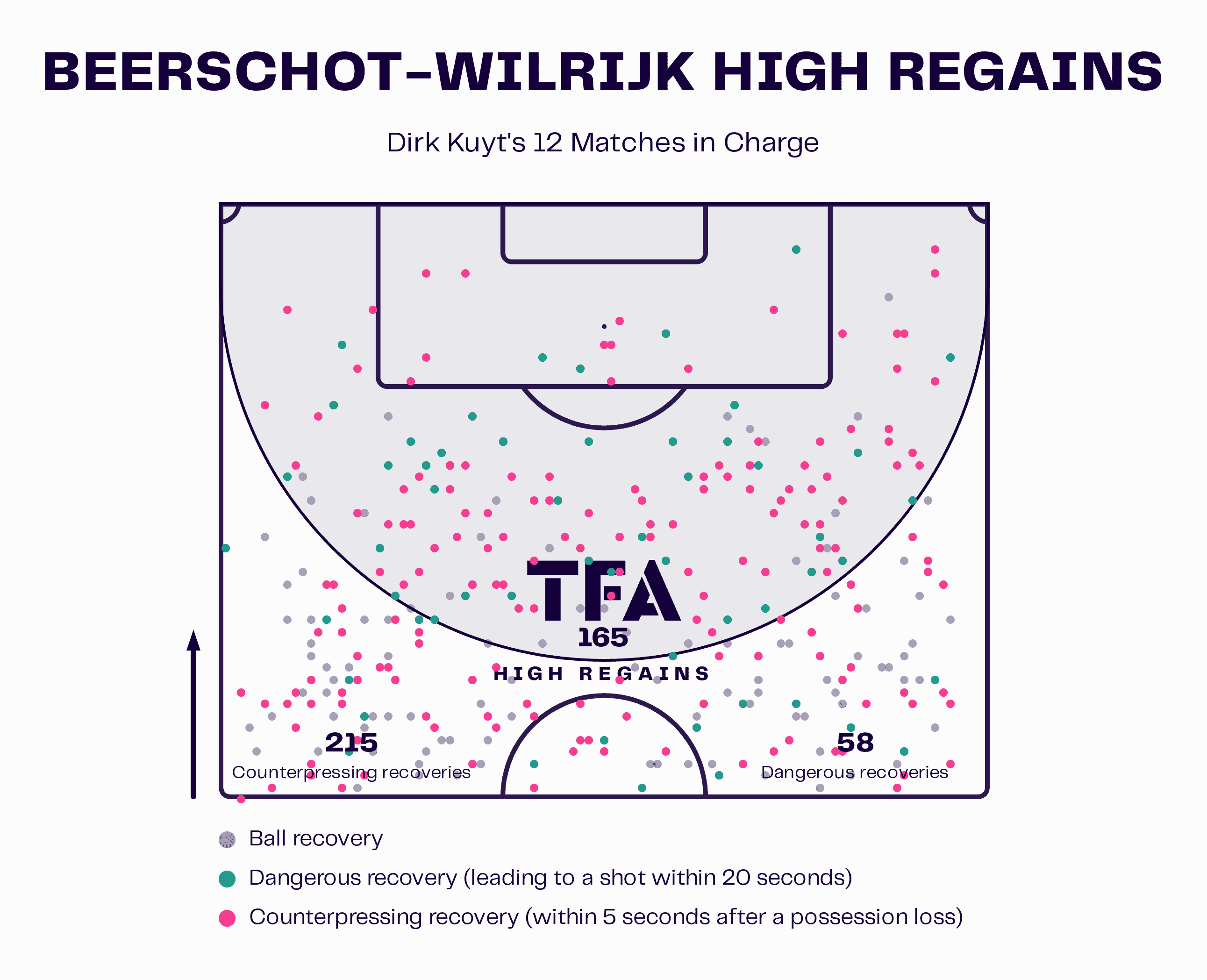
The data viz graphic above shows the high regains and pressing quality of Beerschot since Dirk Kuyt’s arrival at the club at the end of last year. As we can gather from the figure, Beerschot looks to be active in this area of the pitch, with the front three of the Belgian side looking to start in higher positions defensively. Typically, Kuyt’s side looks to let their opposition choose a side before looking to lock it into that side, preventing them from escaping centrally and switching the point of attack.
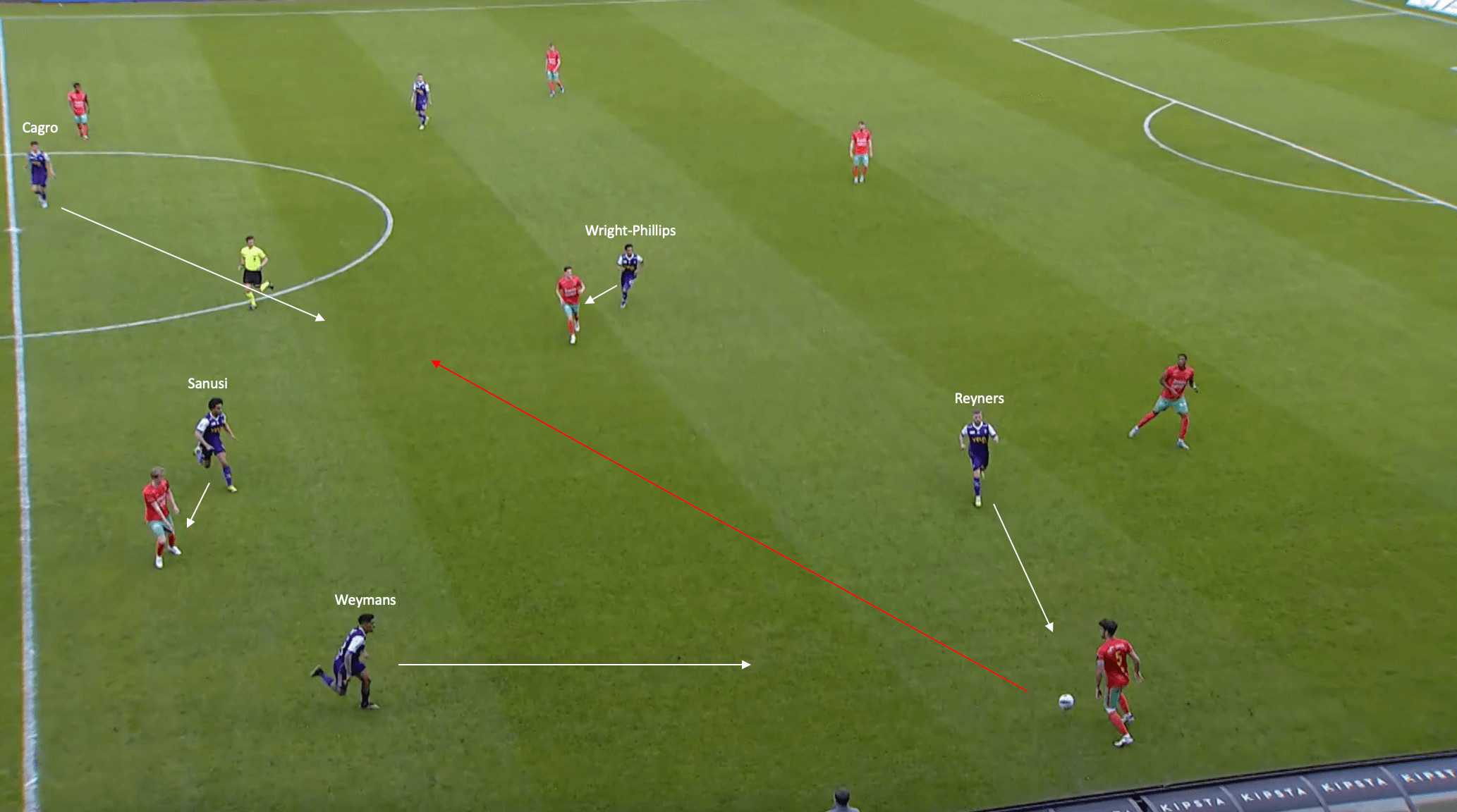
The image above shows a pressing phase of play from Beerschot, and their ability to create turnovers that lead to goalscoring chances. As we can see, the ball is in possession of Oostende, with the Belgian side looking to build out of the back. The ball is circulated over to the full-back on this near touchline, and this is when the Beerschot press gets triggered. The first two lines of pressure, the forward and midfield lines, all look to quickly shift, with the goal to lock the ball onto one side.
As the opposition defender receives possession, he does not have an open body shape, preventing him from playing back to the centre-back and allowing Reyners to put him under pressure without having to necessarily round his run. Also, wide midfielder Marco Weymans came forward from a deeper position to block a potential ball played down the line. In the central areas, Wright-Phillips slides to mark the #6, with Ryan Sanusi tracking the wide midfielder into the wide channel.
The Oostende defender looks to play a dangerous ball centrally, wanting to find the defensive midfielder. However, his ball is overhit, with Cagro able to intercept and get Beerschot going on a dangerous counterattack in an advanced area of the pitch, one that quickly leads to the opening goal of the match.
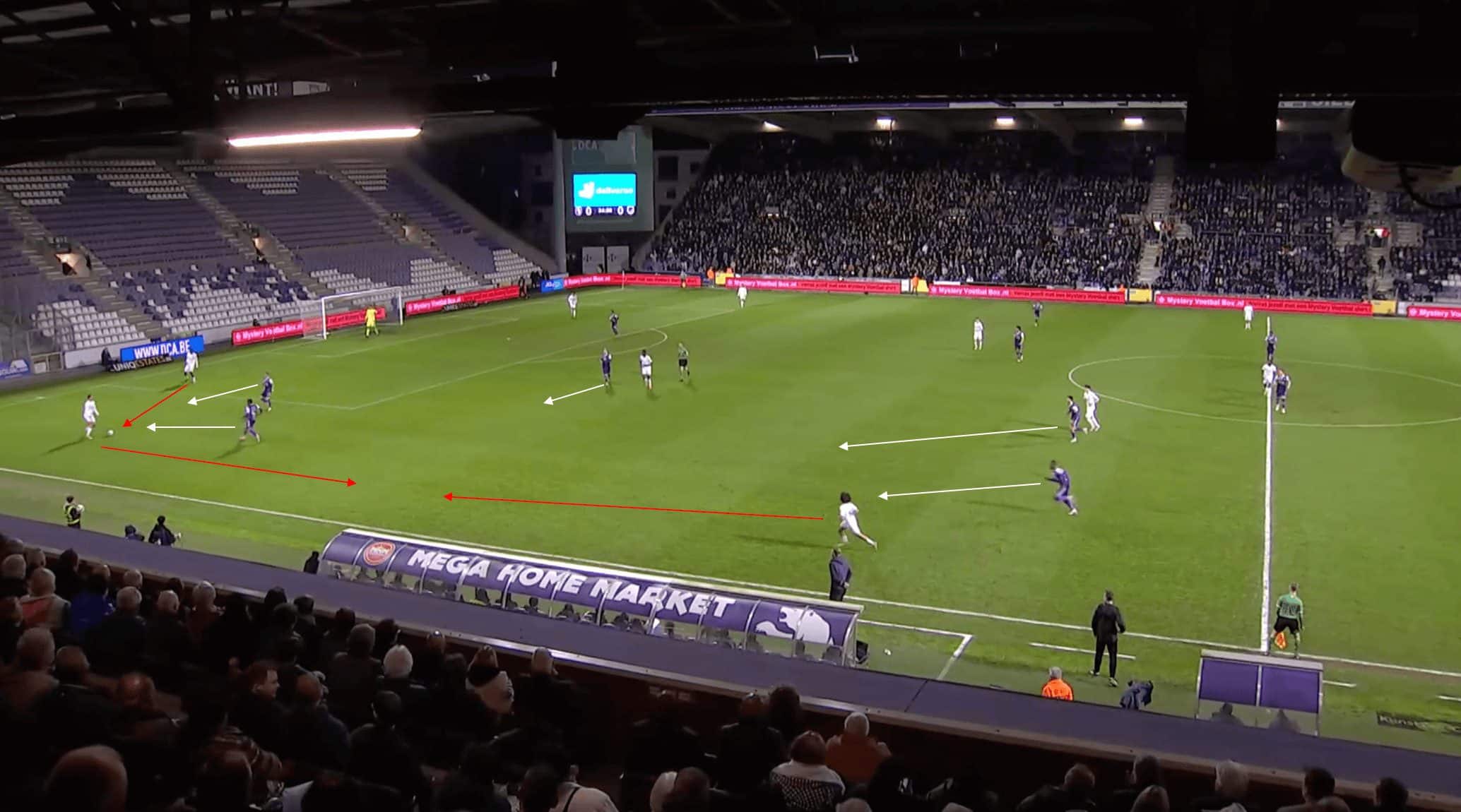
The figure above shows another example of this pressing, with the opposition again looking to play out from the back. As the ball is circulated over to the Genk II full-back in the corner, the Beerschot press is triggered, with the goal to again prevent the opposition from escaping this side. The two closest Beerschot players looked to put immediate pressure on the player in possession, while the rest of the Beerschot defence looked to shift over and lock the ball onto this near side.
Also, the left-sided centre-back from Beerschot is able to release and detach from the backline, with the rest of the defence able to slide and tuck to cover the space left by the onrushing defender. He is able to put immediate pressure on the Genk II player, dropping into the pocket to try and receive the ball on the touchline, getting a touch on the ball, and forcing the ball out for a Genk II throw-in deep inside their own half.
While they have not always been able to create goalscoring chances off of their pressing, they have become a well-drilled side when it comes to shifting and sliding and looking to lock the ball onto one side during pressing opportunities. It is not perfect, and there are still moments where the opposition is able to escape and change the point of attack, putting Kuyt’s side under pressure from a defensive perspective. However, this area of their game is definitely something to continue to keep an eye on in the top flight next season.
Conclusion
As this tactical analysis piece has been able to show, Dirk Kuyt has had a great start to life at Beerschot since being appointed by the club at the end of last year, guiding them to Belgian Pro League for next season. The former Premier League forward has shown that he can lead a side to glory in the Challenger Pro League, and it will be interesting to see how he fares next season in the top tier of Belgian football.





Comments